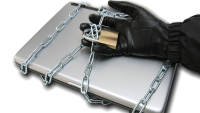 Today, another friend asked me which was a better backup solution Dropbox (http://dropbox.com/ if your going to sign up please use this referral URL http://db.tt/74rAyEsm) or Carbonite (http://carbonite.com). I can see the confusion of Dropbox as a backup solution; it does kind of look like one to most folks. As long as I answered it for my friend, I might as well put it out for others too. Plus I might get some nice feedback on other options.
Today, another friend asked me which was a better backup solution Dropbox (http://dropbox.com/ if your going to sign up please use this referral URL http://db.tt/74rAyEsm) or Carbonite (http://carbonite.com). I can see the confusion of Dropbox as a backup solution; it does kind of look like one to most folks. As long as I answered it for my friend, I might as well put it out for others too. Plus I might get some nice feedback on other options.
To the serious techies (geeks/nerds), Dropbox and Carbonite are not the same solutions. So when you ask them, they might roll their eyes and sigh heavily before answering in a rather belittling tone. Just realize that to them, everyone should clearly understand technology and not make such mistakes. Ignoring their tone here is the information you’ll get. (Oh, and if you want to help them, pat them gently on the shoulder, and say, “It’s okay. I understand you haven’t realized that the world doesn’t revolve around technology. I can help you with that. Please read the book The Inmates Are Running the Asylum by Alan Cooper.”) And now, let’s get to a quick rundown of the technologies, and what I personally do.
Dropbox lets you have a shared folder of pictures, files, etc. which is kept in sync across multiple devices (computers, laptops, and mobile devices like smart phones).
I use Dropbox for things like: my books, shareable pictures, office notes, project notes, and funny items I want to share. I only keep about 4GB of data in Dropbox at any one time. I often remove stuff from it when my Dropbox is getting too full (such as completed projects, rolled out oldest vacation pictures when I add new ones, etc.). These things are either deleted (because I have them someplace else) or moved to my archive folder on my large storage device at home to be kept for eternity.
The vast majority of people only need a small amount of digital storage for their “shared” current projects files, so Dropbox free is perfect for this. It is reasonably secured; if you forget your password, they can’t get you back in. Data is always encrypted when moving over the networks; data on the Dropbox server is stored encrypted (they cannot see it). Your password is the encryption key and the data is only decrypted on your computer; and most of my security super brain friends considered it reasonably safe.
Carbonite is a computer backup solution which will give you an “offsite” backup solution (which I highly recommend having). This is more like having a safety deposit lock box at a bank for keeping copies of your important documents. The whole purpose of the safety deposit box is secured storage someplace other than your house. This is insurance against theft and disaster (fire/flood/earthquake). It isn’t very big and is primarily for items which are difficult to replace or which you will need in an emergency. Things to put into a computer digital safety deposit box are things you cannot replace from someplace else. For example, the software installed on your computer is on a DVD/CD disk. If you need to get a new computer, it is very likely you’ll get brand new up-to-date software, so you do not need to include software in the digital safety deposit box. However, pictures from your vacations, all the scanned love letters from your youth, the digital copy of your taxes (for the last 7 years), etc. should be backed up (aka included in the digital safety deposit box). Your teenagers might insist that their digital music is essential cannot live without data, but again, they can re-download those from Amazon or iTunes whenever they want, so let Amazon and iTunes worry about keeping a copy of those safe for you.
For computer data, I suspect I am not unique. I have about 500GB of “personal data files” which includes every project I ever did, all my pictures and my family pictures, and electronic copies of all my papers (taxes, degrees, legal papers, bills, funny things for all my kids, etc.). This is far too much data to be keeping in Dropbox, and also, it is stuff I don’t want to be “accessible” should someone get my laptop or phone. All of this is data I want back should something happen to my house or computers. This is what I need in my offsite backup, and it is far more than can or should be stored in Dropbox.
This leads us to the offsite backup solutions like Carbonite, Crashplan, and Mozy. I have tried all three for about 6 months each. I had technical issues with Mozy (which are really differences of opinions between them and me) and felt that Crashplan and Carbonite were about the same. I went with Crashplan as they had a multi-computer plan so I have one account but am able to back up all my computers. Essentially, all three of these services are fine solutions; pick the one you like best for what ever unique reasons you might have. Essentially, they are all install, setup, and forget solutions. Make sure you have your backup solution software installed and running on ALL of your computers (laptops, and desktops). These services will NOT keep the files in sync; they will only back them up. The backups are transported and stored securely enough to leave me with little worry of the government looking through my data (to be honest, they could do that easier by walking into my house and looking at my desktop, which is exactly what they will do if they feel the need.)
On one of my home computers, I have a very large external drive (storage device) called a Drobo. (You can buy a Drobo from Amazon https://lartra.com/ref/drobo.) One of the main reasons I picked Drobo is because it was designed to be very careful with the data and totally automated; meaning using it is as simple as plugging it in to the power and your computer with a USB cable. But, Drobo is better than a normal external disk because it is a self-adapting computer that uses some interesting technology called RAID (Redundant Array of Inexpensive Disks) to spread data stored on it across multiple cheap disks. If any single disk fails (note you must have at least two disks in it for this to work) the Drobo is able to figure out what the missing bits were and rebuild my data as if nothing was ever wrong. It is also hot-swappable technology, which means I can add new disks, and take bad disks out without turning anything off.
My Drobo has 5 slots for disks and I keep 4 disks in it and one on a shelf for WHEN another disk will fail. When a disk fails I pop it out, slide in the one from the shelf and immediately order a new disk for the shelf. Total down time ZERO minutes, total cost of a disk failure about $50 for the replacement.
When I am “finished” with some of my files I move them from my Dropbox folder to my Drobo. This is just a simple drag and drop operation while sitting on my home desktop computer. This means that the information I want to keep is taken from all of my other computers, but I still have a copy of it if and when I need it on one of my computers at home, kind of like taking a project folder and locking it into your file cabinet at home when you are no longer working on that project. Everything on my Drobo is configured to be picked up by Crashplan. Crashplan is smart enough to see that I just moved the files, so it doesn’t even re-back them up. Instead it just notes their new location.
So what about super-sensitive data? These are files for work which should NOT be stored on any of my devices in the event of theft or loss. This is where another wonderful, and free, piece of software called Truecrypt comes into play. Don’t just dismiss this if you are not technically savvy enough to be comfortable playing with mounted special drives, and digital encryption technology usage (like ssh, ssh-keys, pgp, etc.). Truecrypt is easy enough to use that it might be good for you. It allows you to create a file which is strongly encrypted that can be “opened” and mounted like a thumb drive. Files put in it are safe once you unmount the drive. I carry a USB thumb drive with a handful of Truecrypt drives for the organizations I work for and personal data. I keep them smallish (roughly 250MB each) to allow them to be backed up easily but also to keep me from putting too much into them. I keep them in sync with their counterparts on the organizations computers using Microsoft’s SyncToy, or the Linux program Unison. This fills in the last crack on how I manage my data.
In summary to protect my data I use a combination of technologies. I cover all the cracks for disaster recovery and theft of devices/data using the right service or technology for each piece of the puzzle. I have a device at home which protects from disk failures (Drobo). I pay for services to keep all of my data backed up someplace other than my house (Crashplan). I keep my current non-sensitive files for projects and personal stuff in sync automatically between all of my computers using Dropbox. Finally for sensitive files I keep those in smallish mountable encrypted drives using the free program Truecrypt and I keep those in sync between the encrypted drives by using Microsofts SyncToy (i.e. I mount one on G: and the USB copy on H: and sync them up, then dismount).
I think that about covers the bits I need to protect. In short, I use:
- A Drobo (https://lartra.com/ref/drobo) on my main desktop computer at home. (This provides huge amounts of storage which is guarded from losses due to disk failures, of which WILL happen from time to time.)
- Dropbox (http://db.tt/74rAyEsm) for my “working files” between all my computers, tablets, and cell phone.
- Crashplan (http://crashplan.com) to back up all the user data (not the whole box just the user directories and all of my Drobo) to an offsite storage facility.
- A USB thumb drive with Truecrypt data files (http://www.truecrypt.org/) on it for any super sensitive stuff kept in sync using Microsoft’s SyncToy (http://www.microsoft.com/download/en/details.aspx?id=15155)
I hope that helps.
This is a revised edition of an earlier article I wrote about a year ago. Everything in it is still accurate and I checked all the links too.
 Leeland Artra is a consistent fantasy/sci-fi bestselling author since his first release in February 2013. He creates deeply developed believable worlds, lovable characters targeted for 13+ readers that enjoy complex plots with a humorous tone as well as emotionally compelling stories that stay with you long after you turn the last page.
Leeland Artra is a consistent fantasy/sci-fi bestselling author since his first release in February 2013. He creates deeply developed believable worlds, lovable characters targeted for 13+ readers that enjoy complex plots with a humorous tone as well as emotionally compelling stories that stay with you long after you turn the last page.
His books routinely earn great reader reviews. Leeland is available to chat with book clubs and welcomes comments and emails from his readers.
You can find all of Leeland’s books from his Amazon author page (http://www.amazon.com/Leeland-Artra/e/B00B87A5EU).



